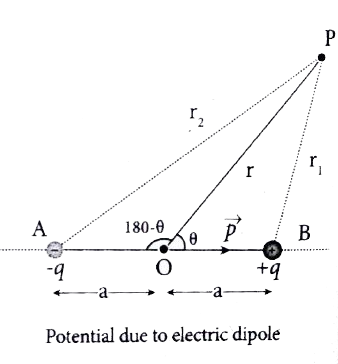Derive an expression for electrostatic potential due to an electric dipole. Solution in Tamil
Electrostatic potential at a point due to an electric dipole: Consider two equal and opposite charges separated by a small distance 2a. The point P is located at a distance r from the midpoint of the dipole. Let θ be the angle between the line OP and dipole axis AB.
Let r1 be the distance of the point P from +q and r2 be the distance of point P from -q.
Potential at P due to charge +q =14πε0qr1
Potential at P due to charge -q =−14πε0qr2
Total potential at the point P, V=14πε0q(1r1−1r2) .....(1)
Suppose if the point P is far away from the dipole, such that r>>a, the equation can be expressed in terms of r. By the cosine law for triangle BOP,
r21=r2+a2−2racosθ=r2(1+a2r2−2arcosθ)

Since the point P is very far from dipole, then r>>a. As a result the term a2r2 is very small and can be neglected. Therefore
r21=r2(1−2acosθr)
1r1=1r(1−2arcosθ)
since ar<<1, we can use binomial theorem and retain the terms up to first order
1r1=1rr(1+arcosθ)
Similarly applying the cousine law for triangle, AOP,
r22=r2+a2−2racos(180−θ) Since cos(180−θ)=−cosθ we get r22=r2+a2+2racosθ
Neglecting the term a2r2(because r>>a)
r22=r2(1+2acosθr)
Using Binomial theorem, we get
1r2=1r(1−acosθr)..........(3)
Substituting equations (3) and (2) in equaltion (1)
V=(1)=14πε0q[1r(1+acosθr)−14(1−acosθr)]=q4πε0[1r(1+acosθr−1+acosθr)]
V=14πε02aqr2cosθ
But the electric dipole moment p=2qa and we get,
V=14πε0(pcosθr2)
Now we can write p cos θ=→p,ˆr, is the unit vector from hte point O to point P. Hence the electric potential at a point P due to an electric dipole is given by V=14πε0→p.ˆrr2(r>>a)...........(4)
Equation (4) is the valid for distance very large compared to the size of the dipole. But for a point dipole, the equation (4) is valid for any distance.
Special cases:
Case (I) If the point P lies on the axial line of the dipole on the side of +q, then θ=0. Then the electric potential becomes V=14πε0pr2
Case (ii) If the point P lies on the axial line of the dipole on the side of -q then θ=180∘, them V=−14πε0pr2
Case (iii) If the point P lies on the equatorial line of the dipole, thena θ=90∘. Hence V=0
Topper's Solved these Questions
Similar Questions
Write down Coulomb 's law in vector form and mention what each term represents .
View SolutionDerive an expression for electrostatic potential energy of the dipole in a uniform electric field .
View SolutionDefine capacitance . Give its unit.
View Solutionकिसी विद्युत् द्विध्रुव के कारण किसी बिन्दु पर विद्युत् विभव होता है :
View SolutionDefine electric potential. Derive and expression for the electric potential due to an electric dipole and hence the electric potential at a point (a) the axial line of electric dipole (b) on the equatorial line of electric dipole.
View SolutionDerive an expression for electrostatic potential due to an electric dipole.
View SolutionWhat is an electric dipole and electric dipole moment? Derive an expression for electric potential at any point due to an electric dipole. Also discuss the special cases.
View SolutionDerive an expression for electrostatic potential due to a point charge .
View SolutionDerive an expression for electrostatic potential due to an electric dipole.
View SolutionDerive an expression for electrostatic potential energy of the dipole in a uniform electric field .
View SolutionElectrostatic potential due to an electric dipole
View SolutionElectrostatic potential due to an electric dipole
View Solution(i) Derive the expression for the specific for the electric potential due to an electric dipole at a point on its axial line.
(ii) Depiet the equivpotential surfaces due to an electric dipole.
View SolutionDerive an expression for electric potential at any point due to electric dipole. Show that the potential at a point on the equatorial line of an electric dipole is zero.
View SolutionDerive an expression for electric potential at-a point due to an electric dipole with the help of diagram and hence calculate electric potential when the point is on the axial lline of electric dipole.
View Solution